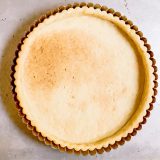It’s almost Thanksgiving, and for me, this holiday is all about pie—more so than turkey, stuffing and all the rest. I’ve been helping with the big meal for most of my life, first at my mother’s elbow and eventually captaining the feast prep myself, and pie was the first thing my mom passed me the reins on.
The humble pie humbled me instantly—it took multiple tries to confidently turn out desserts that were worthy of the Thanksgiving table. The trick to getting it right (and making all the trial and error worth it) was learning a few key tips and techniques. Now, I wait all year for the rush of crossing the finish line on Turkey Day with a couple of golden-brown pies, the buttery, flaky pastry hinting at the perfectly cooked fruit or toasty pecans within.
Satisfaction aside, I wish I would have known a few things starting out, so I’ve pulled together advice from our resident dessert pros that’ll help first-timers and advanced bakers get pie right this year. Get ready for your best holiday slices yet.
Cheese Course Pie
This unconventional pie features a graham cracker crust and includes a jammy fruit topped with a mildly sweet mascarpone cream infused with a bold blue cheese and topped with crunchy toasted walnuts.
Tip No. 1: Keep it Simple
Don’t want to toil over labor-intensive traditional pie dough? You don’t have to. Press-in crusts are infinitely easier (and more forgiving) and work well with everything from cream or custard pies to cheesecake. All you have to do is pulse cookies or biscuits into dust in a food processor—graham crackers are classic, but Oreos, Speculoos and the like also work great—and mix with melted butter until a sandy crumble forms. Then simply press that tightly into your pie tin or spring-form pan and chill in the freezer while you assemble your filling.
“If your crumble isn’t sticking together and forming a crust when you press it in, add a little more melted butter,” says Rose Hattabaugh, a recipe developer in the Milk Street Kitchen.
Single-Crust Pie Dough
This is the master piecrust we’ve all been searching for - bombproof pie dough that is simple to mix, rolls out easily, stands up to handling, bakes up light and flaky, and doesn’t slump or shrink when prebaked.
Tip No. 2: Just Chill
If you’re sticking with a traditional pie dough. The fridge is your best friend.
Chilling pie dough gives the gluten a chance to relax, so it won’t fight you when you roll it out, and allows the flour to hydrate properly—making dough much easier to roll out. Start with the coldest possible butter that you can, and if you feel it melting as you work with it, stick everything back in the freezer for a few minutes. If a recipe step asks you to chill your dough, err on the side of longer in the fridge. Lots of pie recipes romanticize shingling butter into flour with your fingers as the way to get a super-flaky crust. If that doesn’t work for you, skip it. There’s zero shame in using a food processor to incorporate butter into flour (and it’ll keep your ingredients cooler).
And Food Editor Bianca Borges’s advice improved my pie-baking technique infinitely: When you first pull your dough out of the fridge, use your rolling pin to pound it flat, then flip it over and do it again.
“Recipes will tell you to let the dough soften on the countertop after chilling to make it easier to roll out. That means butter is melting! This method softens the dough without heating it up, keeping it cold while giving you a head start on rolling,” says Borges.
Hattabaugh suggests resting the whole assembled pie in the fridge for 20 to 30 minutes before putting it in the oven. When cold butter hits a hot oven, the water in the butter evaporates, generating steam that creates the ideal flaky layers in crust.
Mixed Berry Fruit Crostata
This free form fruit pie, or crostata, maintains a flaky, buttery pastry due to the gap at the top allowing steam to freely escape while baking.
Tip No. 3: Watch Out for Water
When forming your pie, heat is the enemy, but when baking it, water is. If you’re making a fruit pie, especially one with a crust on top or a tight lattice, do yourself a favor and cut slits or leave enough gaps in your design for steam to escape. As your filling cooks, it lets off steam—if it has nowhere to go, it’ll remain trapped inside your pie and create a soggy bottom. I learned that the hard way.
And you have to pick the right fruit for the job. Avoid anything overripe or watery, especially when it comes to stone fruit or berries, like overly juicy peaches.
“They’re great on yogurt, not so much for pies,” says Hattabaugh.
Some recipes ask you to cook your filling ahead of time and bind it with starch; use your judgment here. Apples tend to be pretty forgiving. For pears, look for some with a little give—just enough to be sweet.
Tangy Whipped Cream
This tangy whipped cream - with a hint of tartness from sour cream - perfectly balances the sweetness in your pie recipe.
Tip No. 4: Pack a Final Punch with Whipped Cream
You’ve done all this work. Gild the lily and serve your pie with a flavored whipped cream. “Don’t miss a final opportunity to add a little extra flavor,” says Hattabaugh. I’m a fan of our Tangy Whipped Cream, with gets a hint of tartness from sour cream, but your options are endless. Hattabaugh suggests crème fraîche, yogurt, alcohol, citrus zest, espresso powder, jam, rosewater, spices, peppermint or other extracts or a pinch of freeze-dried fruit as topping boosters.
Our Final Tips:
For any first-timers trying their hand at pie, we recommend a tin or metal pan. They heat up faster than glass or ceramic, conduct heat evenly and brown crusts beautifully.
Sometimes, you do your best to keep everything cold and incorporate your butter into flour and still end up with butter leaking out. That’s okay. “If you end up with a puddle of butter all over the bottom of your pie, try leaving it in the oven a few more minutes,” says Hattabaugh. “Usually, it’ll re-incorporate.” Chances are, it’ll still taste great anyway.
Ready to bake your holiday pies? What will you try? Join the conversation on Facebook, Twitter, Instagram and Pinterest and let us know in the comments!







